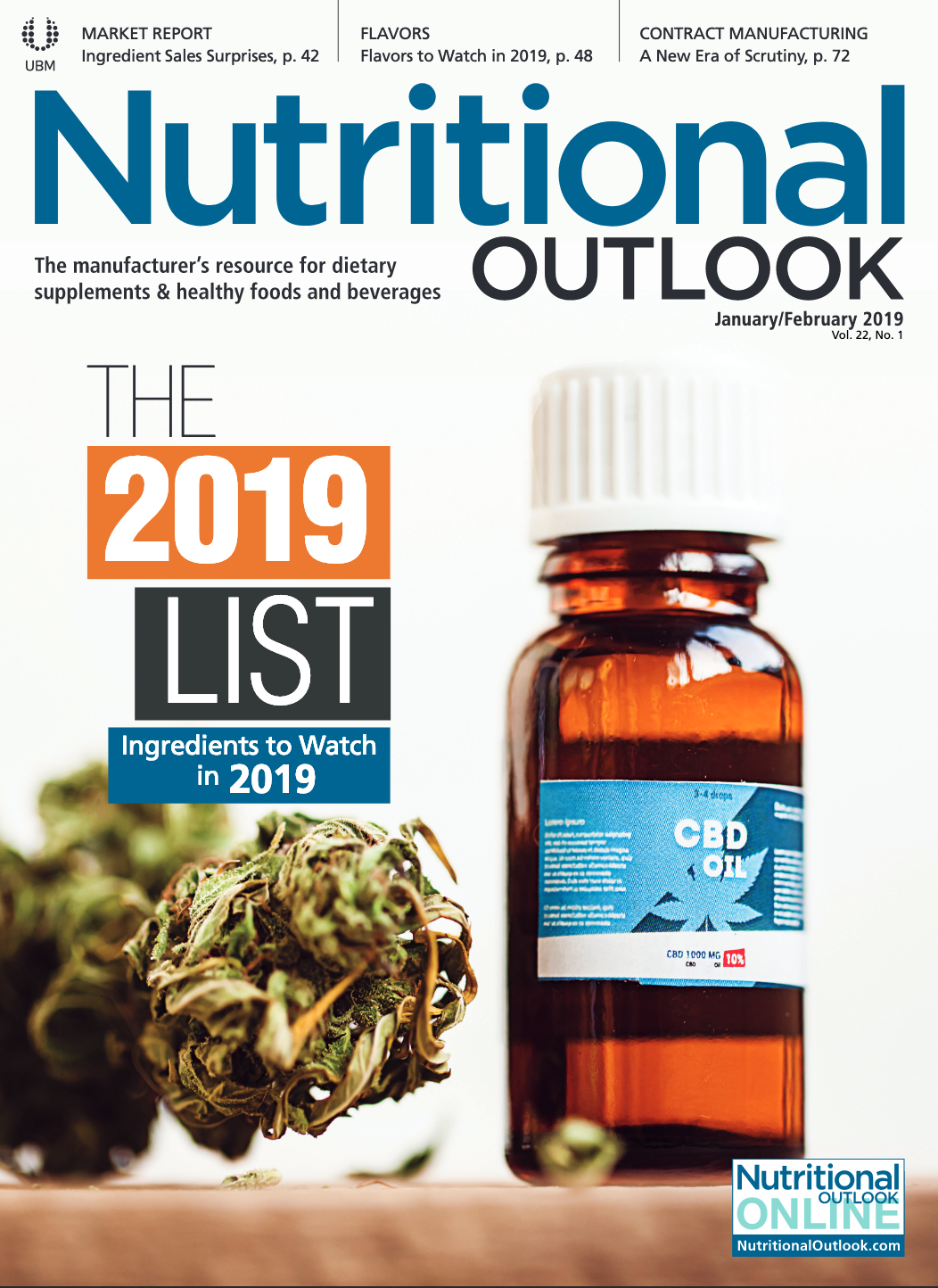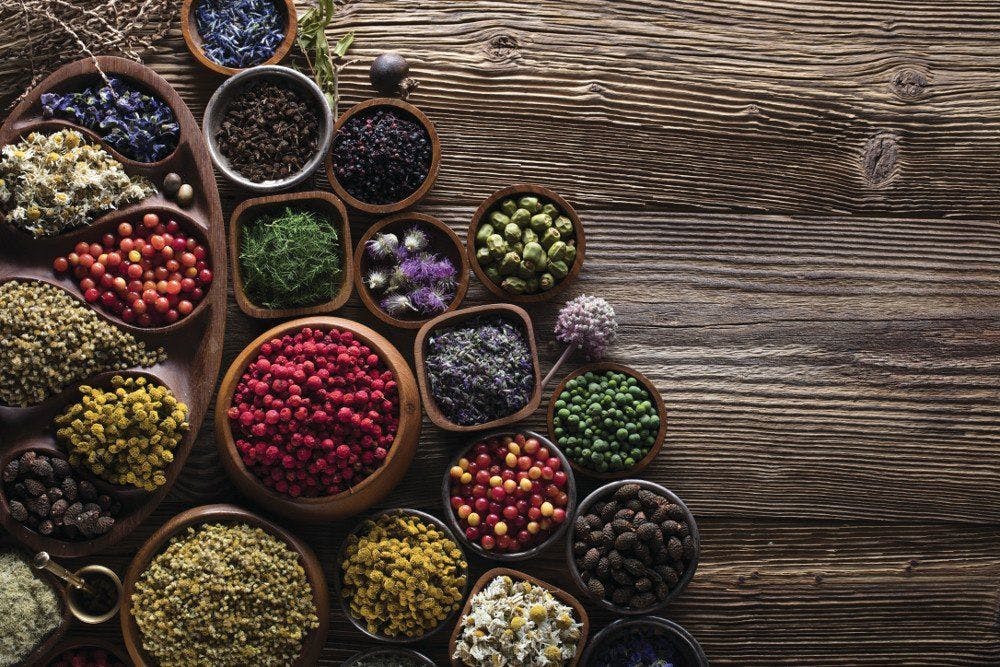2019 Flavor trends for food and beverage
Experts predict 2019’s hottest food and beverage flavors.
Photo © AdobeStock.com/Natalia Klenova

Which flavors are hot in 2019? Leading flavor houses gave Nutritional Outlook their predictions for which flavors consumers will be looking for in food and drinks in the coming year. As has been the case with Nutritional Outlook’s previous yearly forecasts (2018, 2017, 2016, 2015, 2014), the macro trend for 2019 appears again to be a balance between flavors that consumers find familiar and comforting alongside flavors that satisfy their craving for a flavor adventure.
“Americans have begun to step out of their comfort zones with the thirst to explore authentic and unconventional taste experiences,” said flavor firm Kerry (Beloit, WI) in a recent press release announcing the company’s 2019 Taste Charts predicting 2019 trends. “There is also a unique balance between nostalgic taste and avantgarde experiences that consumers seek today.”
Here are some macro and micro trends formulators should keep in mind.
Florals and Herbs
Floral flavors have gained a following in recent years, and 2019 is no different. Firmenich (Geneva) has declared hibiscus as its 2019 Flavor of the Year “based on the growing appeal of florals in food and drink.”
“Hibiscus is a beautiful and tasty choice for 2019,” the company said in a press release, pointing to hibiscus’s appealing attributes, including its natural origin and “slightly tangy” profile. Firmenich points to global data from market researcher Mintel’s global consumer database indicating that the worldwide use of hibiscus in new food and beverage product launches has grown 300% since 2012. Hibiscus is becoming popular in yogurt, beer, tea, and chocolates, and is especially popular in the United States, Brazil, Mexico, and Denmark, with growth also happening in Spain and Italy.
Consumers are drawn to hibiscus for its many health benefits, says Firmenich, including its use in traditional medicine. “Hibiscus is more than just a pretty flower,” the company said. “Egyptians used hibiscus tea to lower body temperature and treat heart and nerve diseases. In African countries, the tea was used to treat cold symptoms, and pulp made from the leaves was applied to the skin to heal wounds. Recent studies show promise for both the tea and the hibiscus plant extract to lower blood pressure and cholesterol levels.”
Consumers looking for healthier, reduced-sugar beverages are also looking for flavors like hibiscus to replace sweetness and to “help deliver sensorial impact and provide interesting and novel taste experiences,” said Jeff Schmoyer, Firmenich’s vice president of global consumer insights, in the press release.
Currently, hibiscus’s most popular use has been as an infusion in beverages, but Firmenich expects applications to broaden. Fausto Carriles, a senior Firmenich flavorist in Latin America, pointed out that hibiscus has “a strong floral aroma,” alongside “a woody-astringent character” and “a subtle and delicate fruity undertone, even a hint of green like freshly cut mint leaves.” Hibiscus’s year-round appeal spans use in cold summer beverages to inclusion in “winter hot fruit punches,” Carriles added. Hibiscus is also popular in savory products. It is used in Mexican cuisine and ceviche applications and has been seen in savory foods such as enchiladas and dried hibiscus garlic chips, Firmenich says.
As mentioned, hibiscus also taps into a general growing appreciation for florals-driven, in part, by the visual appeal of florals, a powerful marketing tool. Of hibiscus, Firmenich says, “No doubt their ‘Instagrammable’ nature has helped propel them onto the mainstage along with their floral friends: lavender, elderflower, rose, and violet.”
Firmenich calls hibiscus “unusual but approachable,” noting that it balances new experiences with comfort-qualities that are infinitely sought by today’s generation of shoppers. Firmenich even likens hibiscus’s qualities with those attributed to Pantone’s 2019 Color of the Year: “Living Coral.” Pantone describes Living Coral as “vibrant yet mellow,” noting that it is a warm, lighthearted, joyful, and “nurturing color that appears in our natural surroundings and at the same time displays a lively presence within social media” and “provide[s] comfort.” The same can be said of hibiscus.
Like Firmenich, flavor firm ADM (Erlanger, KY) says that the same consumer interests that drove Pantone to select Living Coral as flavor of the year are also inspiring a trend toward all flavors pink-from rose to rosé, the company says.
“Currently, pink is considered the height of sophistication-even dominating the fashion scene-since Living Coral, or vibrant living pink, has been announced as Pantone’s 2019 Color of the Year,” says Marie Wright, vice president and chief global flavorist, ADM WILD Flavors. “Products covering an expansive range of pink hues are popping up all over the globe. Because of this, we predict bright, vibrant ‘pink’ flavors will increase to match this trend. Pink flavors include rose, rosé wine, hibiscus, elderflower or berry, watermelon, pink grapefruit, rhubarb, and berries.”
For instance, Wright says, this past summer her company observed an increase in global rosé wines, champagnes, and sparkling wines, and, subsequently, an increase in rosé-flavored and -scented products. “Because of this, we predict rosé wine–flavored and/or -fragranced everything will be an explosive trend in 2019-from rosé wine–flavored gummy bears to chocolate, ice cream, cakes and cookies, jelly, near water, cider beverages, cocktail and mocktail ready-to-drink beverages, candles, deodorants, perfumes, and more. 2019 will see rosé wine flavor going mainstream.” Wright also highlights global growing demand for pink gins today, often flavored with blends of rose, rhubarb, berries, citrus, and spices.
In the same vein, pink florals should do well in 2019, Wright says. “In 2019, we predict products will be blooming with the luscious flavors of rose, hibiscus, and elderflower. Oils, extracts and petals are used to flavor dishes and food products across many categories. Rose and lavender (not so pink) flavors are finding their way into cookies, chocolate, ice cream, lattes, and alcoholic beverages.”
Lavender is also a key floral flavor pegged by Synergy Flavors (Wauconda, IL) for 2019. Synergy applications technologist Kayla Blanding says: “Going into 2019 and beyond, Synergy Flavors sees a bright future for lavender due to the fact that floral and botanical flavors continue to have widespread appeal.” She notes that while lavender alone hasn’t yet gone mainstream, “it pairs well with a variety of other flavors, including herbs, citrus, fruit, sweet flavors, and savory options as well.” In the culinary world, it’s still regarded as an artisanal flavor, appearing in stylish fare such as lavender lattes. Blanding notes that chefs and food manufacturers have put new twists on lavender, including “lavender smoke.” And, like Firmenich of hibiscus, she calls lavender “very Instagram-worthy.”
Comax Flavors (Melville, NY) is also firmly entrenched in the floral trend. Late last year, the company introduced its new Classic Floral Collection, representing the first flavor collection the company created in its new innovation center in Marlton, NJ. In a press release announcing the new collection, the company said, “Floral flavors are blooming and making their way into a variety of food and beverages. According to Technavio, the global floral flavors market is expected to grow at a CAGR of almost 10% during the period 2018-2022.” The Comax Classic Floral Collection includes: 1) honeysuckle (“mild sweet, fruity, citrus, and honeylike undertones” suited to fruit and dairy desserts and sweet sauces), 2) jasmine (a “classic white floral with mild fruity, rosy, and tea-like undertones” suited for tea and savory Asian dishes), 3) lavender (“subtle hints of citrus, mint, and peppery-like nuances” and that “pairs well with berry flavors such as blueberry and spicy notes” and is used in beverages, cream desserts, and seafood), 4) lilac (“sweet fruity and spicy nuances,” “commonly used in jams/jellies and as a background note in savory meat dishes”), 5) orange blossom (“works well with savory meat dishes and traditional desserts”), and 6) rose (“with very subtle spicy nuances and honey accords” that are “versatile” in tea, syrups, jams, and sweet desserts).
Flavor firm Kerry also notes the “interesting rise” in floral and botanical flavors, highlighting rose as an emerging flavor in sweet products, alongside chamomile and saffron.
Finally, as interest in hemp grows, flavor firm Doehler GmbH (Darmstadt, Germany) notes that hemp’s flavor is finding a following of its own. “Hemp is regarded as one of the oldest plants known to mankind and is used in many diverse applications, as well as purely ornamentally,” the firm says. “The unmistakable spicy-sweet aroma of hemp is well on its way to taking one of the top positions in lists of trendy flavors.”
Fruits and Veggies
Fruit- and vegetable-derived flavors remain a classic and expansive palette for formulators. Flavor firms note a few standouts in 2019-some of which consumers may be less familiar.
“Yuzu is a citrus fruit that is new to American consumers and generally very novel, but it has been making appearances across food and beverage categories more frequently as cultural influences and interest in diverse flavors increase,” says Synergy’s Blanding. Yuzu is grown in China and Tibet and is now seen in emerging categories like sparkling beverages, she says, adding that it “combines well with familiar and fruity flavors such as mint, apple, and lemon” and tastes like “a cross between grapefruit and lime.” In particular, Synergy predicts yuzu as a trending flavor in high-acid sports nutrition beverages.
Doehler also points to yuzu’s growing profile alongside newer citrus flavors which the firm dubs “Citrus Fruits 2.0.” The firm says: “Besides the ‘classics’ and all-time favorites, such as orange, lemon, and lime, new and unusual citrus aromas are gradually gaining in popularity. ‘Orange is no longer just an orange’-something more is needed. This is why ‘Citrus Fruits 2.0,' [fruits] which are native to Asia, such as calamondin [also known as calamansi], kumquat, or yuzu, are impressing consumers with their exceptionally complex flavors that offer interesting and innovative options for food and beverage applications.”
Over in veggies, Symrise (Holzminden, Germany) calls kohlrabi, also known as “German turnip,” a “contender to be the next kale.” Emmanuel Laroche, vice president, marketing and consumer insights for Symrise, says kohlrabi “is sprouting up on menus across the U.S,” including in ice cream.
Even the most common flavors continue to hold court-including banana, says flavor firm Virginia Dare (Brooklyn, NY). “Banana is a familiar flavor, one that we expect to grow in 2019 as a way to upscale applications like ice cream, craft beers, smoothies, and more,” says Virginia Dare marketing and consumer insights manager Philip Caputo. “Because of its association with elegant desserts like bananas foster crème brûlée, banana cream pie, and banoffee pie, regular and caramelized banana is a flavor we anticipate seeing on more store shelves and menus.”
Sweet, Savory, and Bitter
Some flavors are pegged as standouts in the sweet and savory field in 2019.
In its 2019 Taste Charts, under emerging flavors for sweet products, Kerry credits the following as having a newer, growing presence: nectarine, florals (again, chamomile, rose, and saffron), basil, guava, savory flavors (miso, rosemary, sea salt, olive oil, bacon, cheese, and chamoy), ube, horchata, buttermilk, passion fruit, cola, smoke, ginger, chai, wasabi, agrodolce, and plum.
In salty snacks, these are trending, Kerry says: lemon, thai curry, rosemary, pink peppercorn, sesame, pepperoni, chai, gochujang, truffle, seaweed, strawberry, piri piri, Korean BBQ, cranberry, basil, vanilla, maple, kimchi, cilantro, and ghee. And in savory products, Kerry predicts innovation with: finger limes, calamansi, karashi, baharat, chervil, nduja, sumac, galangal, sambal oelek, fish sauce, dukkah, nori, adobo, tahini, berbere, agrodolce, za’atar, togarashi, beer, and bagoong.
Honey, maple, and molasses are also strong performers, firms say. Megan Byrnes, marketing representative for Gold Coast Ingredients (Commerce, CA), says: “At Gold Coast Ingredients, we predict we’ll see a more outstanding variety of honey-flavored products on the market in 2019. Honey flavor has become popular in its simple, pure form, caramelized, as well as used to complement other flavors”-for instance, she says, pistachio and honey, milk and honey, lemon and honey, and orange and honey. Also, she adds, “Two other honey flavors to watch in 2019 are honeycomb candy flavor and chocolate honeycomb candy flavor.” Honeycomb candy remains a classic in Australia, New Zealand, and Europe, but Trent reports seeing more activity in the U.S., especially in flavored dairy, bakery, and nutraceutical applications.
Maple is also an up-and-comer. “Pumpkin spice has led the fall flavor conversation the past few years, but we’ve started to notice a considerable migration toward maple,” says Virginia Dare’s Caputo. “Consumption of maple syrup-and, resultingly, use of the flavor-has grown in both the United States and Canada in the past two years, and we expect this trend to continue with new flavored spirits, coffees, lemonades, and more.”
Molasses also shows promise, says Synergy Flavors. Blanding says: “Synergy Flavors continues to see a constant need for sweet brown flavors, and molasses is an inspiring flavor that has yet to see major market growth. That will soon be changing because, like burnt caramel, molasses has the potential to intrigue consumers. It is a flavor that many are familiar with, evoking warmth, nostalgia, and feelings of homemade goodness.” In addition, Blanding says, molasses connotes a natural, “pure” image, and, she says, serves as a natural sugar replacer because it has the lowest sugar content among sugarcane products.
And Gold Coast’s Byrnes says crème brûlée continues to be a popular sweet flavor. “We foresee crème brûlée as an innovative indulgent flavor in 2019,” she says. “Flavors that have sparked our attention are traditional crème brûlée, cinnamon crème brûlée, pumpkin crème brûlée, and toffee crème brûlée. Product developers have experimented with crème brûlée flavors in protein supplements, snack foods, oatmeal, ice cream, and other sweet applications.”
Meanwhile, Kerry predicts that nostalgic sweet flavors-snickerdoodle, cookie dough, and s’mores-will continue to inspire the sweet flavor toolbox.
Bitter flavors are also in vogue. Flavor firm Doehler points to interest in wormwood as a strong indication. “Bitter is the new sweet,” the company says. “Modern consumers are increasingly on the lookout for less sweet, more mature and sophisticated tastes, and the complex, bitter-herbal flavor profile of wormwood fulfils this demand perfectly. Besides its well-known use as one of the main flavoring ingredients in vermouth wine, wormwood can also be used to add taste to natural bitter drinks, alcoholic or non-alcoholic aperitifs, and a variety of other innovative concepts.”
Smoked and Fermented
Increasingly, flavors in the smoked and fermented categories are finding more consumer fans.
Smoked flavors are becoming more sophisticated, Gold Coast’s Byrnes points out. “Keep an eye out for new and improved smoke-type flavors in 2019,” she says. “Subtle smoke flavor notes are added to both sweet and savory applications, such as nutrition bars and healthy snack mixes.”
Interestingly, she notes, Proposition 65 regulations regarding hazardous chemicals are driving fans of smoky flavors to seek out substitutes. “As a reaction to market demands, flavor companies are developing smoke-type flavors without any actual smoke,” she says. “Common smoke flavor profiles include hickory smoke and mesquite smoke, and we predict the smokeless smoke flavor trend will escalate in 2019 with flavor profiles such as applewood, maplewood, and cherrywood smoke-type flavors.”
Oakwood, which offers a smoky flavor, is also seeing more activity, says Doehler. “Oakwood is characterised by rustic and slightly smoky notes, often with hints of vanilla and caramel,” the company says. “Its exciting flavor is not just found in barreled spirits and fragrances for men, but is rapidly becoming a trendy ingredient in cocktails, adult teas, and barrique beverage concepts, as it creates new and exciting taste profiles. Oak aroma can also be found in foods such as fish and meat products, cheese, seasonings, sauces, etc., and adds a smoky and spicy flavor to them. It is certainly one of the most exciting flavors to keep an eye out for in the coming year.”
Comax Flavors points to the continued growth of fermented flavors, including five spice kombucha, pickled beet and onion, and pickled peach. “Fermented and pickled foods and beverages are having a revival,” said the company in a recent press release predicting flavor trends for 2019. “This renewed interest is driven by consumers gravitating towards probiotics and friendly bacteria that support digestive health coupled with consumers’ interest in bold tastes.” Comax points to sales reports from market researcher SPINS showing that U.S. retail sales of refrigerated kombucha and other fermented beverages grew 37.4% to $556 million in 2017.
Around the World
Global flavors continue to make their mark stateside as consumers expand their taste horizons.
“I think the interest in global flavors will continue into 2019 and beyond,” says Roger Lane, marketing manager, savory flavors, Sensient Technologies (Milwaukee, WI). “Consumers are simply too tuned-in to what’s happening around the world for continued exploration not to happen.”
“As Americans gain more familiarity and affinity for international taste, Moroccan, Mediterranean, and Asian flavors continue to grow, such as agrodolce, baharat, bagoong, and many more,” says Soumya Nair, director of marketing insights for Kerry.
“The variety of oriental flavors is in vogue,” says Doehler, highlighting trending flavors such as those from dates, figs, multifaceted spice blends, turmeric, and Moroccan mint. “Oriental flavors impress with their wonderful diversity of intensive taste profiles and can trigger positive associations, such as a holiday memory, as well as alternations of familiar flavors...With almost unlimited fields of application possible, such as instant noodles, table sauces, snack mixes, teas, or gin, these flavors are certainly worth keeping an eye on.”
ADM predicts that in 2019, "Za’atar, a Middle Eastern blend of oregano, sumac, thyme, sesame seeds, and salt, will take center stage. Other global culinary flavors for 2019 include Korean BBQ, Thai lemongrass, and buffalo," says Wright.
Increasingly sophisticated consumer tastes are influencing how formulators work with regional flavors. “Kerry’s predictions forecast that 2019 will bring further specificity to the origin of flavors as ingredients as consumers seek tastes that delight, surprise, and excite them,” Kerry said in its press release.
With specificity in mind, Sensient’s Lane says “hyper-regionalized” flavors are replacing more commonplace regional flavors. “For example,” he says, “Asian flavors have been around for ages, but we’re seeing interest in Macanese cuisine surge. It’s the perfect fusion food as it combines influences from South America, Europe, and Asia.”
As formulators put new flavors on consumers’ taste maps, marketing stories can also capitalize on the exotic background behind those ingredients. “Products that are created with ingredients that are traceable and have provenance claims can be the nudge that a casual browser needs to engage with a particular product,” says Keera Perumbala, marketing associate, sweet and beverage flavors, Sensient Technologies. “A ‘Brazilian orange’ carries more appeal than an ‘orange.’”
Indian cuisine is a huge interest area, says Comax Flavors. “Over the last few years, we’ve seen Indian ingredients such as cardamom, coriander, curry, and garam masala emerge,” said Catherine Armstrong, vice president of corporate communications, Comax Flavors, in a press release. “Comax thinks Indian food is ripe for the American palate,” she said. It inspired the company’s “Passage to India” flavor portfolio, which includes Indian vegetable curry, mango lassi, and masala spiced donut. These flavors are showing up in everything from savory products, dressings, and sauces to dairy, ice cream, plant-based applications, baked goods, and nutrition and performance products.
Virginia Dare also highlights India-inspired hybrid flavors. “This year, don’t be surprised to see consumers’ adventurous taste buds lead them to Indian-inspired flavors,” says Caputo. “Consumers love pairing the familiar with the exotic, and Indian flavors are an area we see benefitting from this. Look for hybrid flavors like cardamom mocha, cardamom white chocolate, chai caramel, chai molasses, garam masala gingersnap, maple cumin, and maple curry spice blend.”
Interest in Indian flavors is also driving the rise of marigold as a flavor, according to Symrise, which notes recent chef inspirations that include marigold syrup and muhammara with piquillo, almond, pomegranate, and marigold.
Japanese food continues to influence flavors here. Symrise’s Laroche calls shiso “more than just your sushi sidekick. It’s now being used as a flavor agent in dishes, drinks, and desserts.” Kerry’s Soumya Nair points to miso as a growing flavor trend. Russian cuisine and its focus on rich and hearty foods are also translating stateside, Symrise’s Laroche says.
Cultural fusion is also a big draw. For instance, “Both Japanese and Italian cuisine share common elements-most notably, an emphasis on seasonality and simplicity,” Laroche says. Together, these flavors can be even better.
And even as consumers travel outside of their taste comfort zones, maintaining an element of the familiar is also a good idea. “While consumers do love to try new flavors and explore new cuisines, they do like a touch of the classic to be included to make it a bit more familiar,” says Sensient’s Lane. “For example, Middle Eastern cuisine is blowing up, and the flavors themselves are actually fairly familiar, but taking those flavors and combining them with something like mayonnaise or ranch makes them more accessible to consumers.” Also, he says, combining exotic cuisine flavors with product formats more familiar to consumers establishes a solid introduction path. He suggests: “Why not create a Korean-style burrito using ingredients found in typical Korean fare, but wrapped in a tortilla for a format everyone knows?”
Health Benefits
There are also flavors whose health appeal is perfectly in line with the general growing consumer interest in functional, healthy products. This is what has driven the rise of a superstar spice like turmeric.
“Over the past three years, functionality has grown steadily to gain mainstream presence across health, wellness, and indulgent product categories,” says Kerry’s Nair. “We have closely followed the growth of turmeric, as it continues to move on an upward slope. Following closely, under the added-functionality benefit, are ashwagandha and holy basil, to name a few. The inclusion of these ingredients as a healthy addition is growing in consumer popularity.”
Sensient’s Perumbala says, “The past decade has seen an increased focus on health and wellness dictating consumers’ lifestyle choices, particularly where it includes food and beverage. This is reflective in the increased discussion around gut health and the number of products with probiotics, and the rise in the popularity and use of ingredients such as turmeric, ginger, and other adaptogens such as ginseng or tulsi.”
Botanical herbs and flavors that help consumers de-stress or give them more energy are also gaining fans, Perumbala says. Perumbala points to interest in “products taking advantage of natural energy and antioxidant sources, as we see more products with guayusa or yerba mate or elderberry extracts.”
Oats are a healthy ingredient that several flavor firms call out as a flavor to watch in 2019. Specifically: “Oat milk exploded in popularity in 2018 as an almond and soymilk alternative-a creamier alternative, according to devotees, including specialty-coffee consumers,” says Virginia Dare’s Caputo. “Considering this trend alongside the continued popularity of overnight oats and a general move toward increased fiber intake, we expected toasted oat to grow as a flavor in shakes, cereals, and more in 2019.” In its 2019 Taste Charts, Kerry also calls out oat milk as a growing alternative ingredient.
Coffee-particularly cold-brew coffee-continues to see heightened activity due to the healthy halo around coffee in general, says ADM's Marie Wright. In addition, she says, "Red coffee cherries, or cascara, are also booming in consumption due to their 'super-powers,' and we predict an emergence of cascara-flavored products in 2019, especially in good-for-you products. Mushroom coffee is another global trend for 2019, spurred by the health benefits associated with mushrooms such as chaga or lion’s mane. We see this flavor emerging in 2019 with associated applications such as ready-to-drink beverages, cookies, and ice cream." Also, she notes, coffee consumption is growing globally among younger consumers (13-18 years of age). These customers, she says, "prefer creamy and sweet coffee beverages such as shakes, smoothies, and twists on lattes. Coffee creamy flavors will continue to emerge in other products such as nutritional shakes, cookies, muffins, and ice cream."
The Whole Package
Finally, in order for flavors, especially less familiar ones, to get a good reception from consumers, Sensient’s Perumbala reminds formulators to remember the importance of other attributes that contribute to a flavor’s appeal.
“We will continue to see products that are experiential in nature, engaging multiple senses at the same time,” Perumbala says. “Texture and visual impact play a big role in delivering these share-worthy experiences that the younger generation craves. Edgy flavors and bold colors turn ‘over the top’ into the new norm, and this is being emphasized in food and drinks with attention-grabbing ingredients that create sensations and elevate the consumption experience.”


























